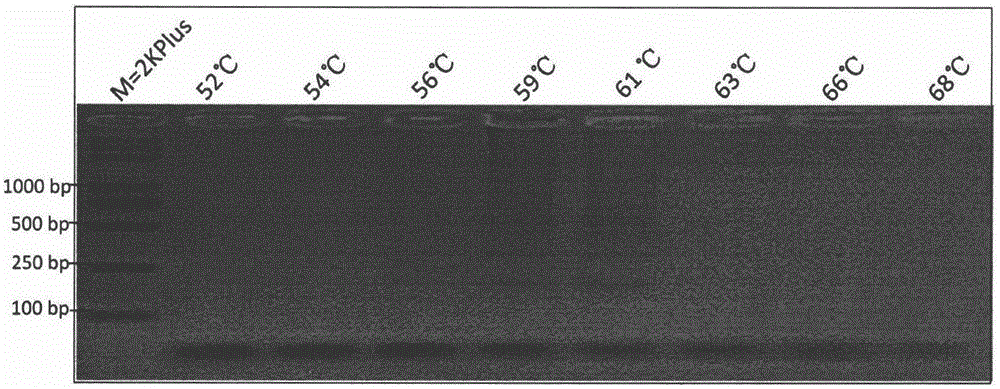Method for fast detecting botryis cinerea's resistance to QoI type bactericides and primer composition
A technology for Botrytis cinerea and detection primers, applied in the biological field, can solve the problems of expensive thermal cycler, time-consuming, low accuracy, etc., achieve the effect of getting rid of the dependence of thermal cycler, saving instruments and equipment, and increasing application value
- Summary
- Abstract
- Description
- Claims
- Application Information
AI Technical Summary
Problems solved by technology
Method used
Image
Examples
Embodiment 1
[0042] The specific experiment of embodiment 1LAMP reaction primer composition
[0043] In order to verify the specificity of the LAMP reaction primer composition, LAMP primers were designed based on the mutation of the 143rd amino acid codon GGT (Gly) → GCT (Ala) of the Botrytis cinerea cytb gene (AB262969.1), and the mutation position The point is located at the 3' end of the forward internal primer FIP, and any or any two bases are carried out for mismatch mutation between the upstream and downstream of the mutation site. A total of 7 sets of LAMP primers are designed, which are sensitive to Botrytis cinerea. The bacterial strain and the DNA of Botrytis cinerea resistant genotype G143A to QoI fungicides were used as templates for LAMP experiments, and a LAMP primer composition capable of specifically detecting the resistance of Botrytis cinerea to QoI fungicides was optimized.
[0044] The specific sequences of each primer are as follows:
[0045] FIP: 5'-CCAATTCATGGTACAGC...
Embodiment 2
[0050] Embodiment 2 LAMP reaction system and detection kit system optimization
[0051] In order to save the identification cost and ensure the stability and reliability of the identification method, BstDNA polymerase (8U / μL) (0.8-4.0U), Mg 2+ (25mM) concentration (0.6-2.0μL), primer FIP / BIP (40μM) and F3 / B3 (10μM) concentration (0.1-0.5μL), betaine (8M) concentration (0.4-2.0μL), HNB (2.5mM ) concentration (0.4-1.2μL) was optimized, and the best system (1mL detection solution) of each component in the kit was determined to be: 1mL detection solution, the detection solution comprising: 1.2μM forward internal primer FIP, 1.2 μM reverse inner primer BIP, 0.3 μM forward outer primer F3, 0.3 μM reverse outer primer B3, 60 μL 10×ThermoPolBuffer, 1.5 mM MgCl 2 , 1.0mMdNTPs, 0.2M betaine, 1.5mM hydroxybromophenol blue (HNB), 160UB stDNA polymerase, prepared by adding sterile ultrapure water, 100 packs, transported at low temperature, stored at -20°C, valid for 1 year.
[0052] Wher...
Embodiment 3
[0057] Embodiment 3 LAMP reaction parameter optimization
[0058] In order to obtain the most suitable reaction temperature and time and ensure the high efficiency of the detection method, when the time is set to 60min, the reaction temperature is optimized at 52-68°C; when the temperature is set at 60°C, the reaction time is optimized at 15-120min; After observing the color change and the gel electrophoresis ladder strip, it is concluded that the reaction temperature is 59-61°C ( figure 1 , figure 2 ) and the reaction time is 45 ~ 120min ( image 3 , Figure 4 ) can achieve LAMP amplification.
PUM
 Login to View More
Login to View More Abstract
Description
Claims
Application Information
 Login to View More
Login to View More - R&D
- Intellectual Property
- Life Sciences
- Materials
- Tech Scout
- Unparalleled Data Quality
- Higher Quality Content
- 60% Fewer Hallucinations
Browse by: Latest US Patents, China's latest patents, Technical Efficacy Thesaurus, Application Domain, Technology Topic, Popular Technical Reports.
© 2025 PatSnap. All rights reserved.Legal|Privacy policy|Modern Slavery Act Transparency Statement|Sitemap|About US| Contact US: help@patsnap.com



